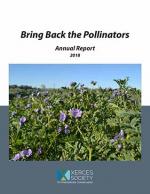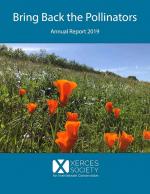As a science-based organization, the Xerces Society produces dozens of publications annually, all of which employ the best available research to guide effective conservation efforts. Our publications range from guidelines for land managers, to brochures offering overviews of key concepts related to invertebrate conservation, from books about supporting pollinators in farmland, to region-specific plant lists. We hope that whatever you are seeking—whether it's guidance on making a home or community garden pollinator-friendly, advice on developing a local pesticide reduction strategy, or detailed information on restoring habitat—you will find it here!
Find Publications
Use the search functions to sort by publication type (books, guidelines, fact sheets, etc.), location, and/or subject (agriculture, gardens, pollinators, pesticides, etc.).
An annual report of the Xerces Society's Pollinator Conservation Program’s conservation efforts.
An annual report of the Xerces Society's Pollinator Conservation Program’s conservation efforts.
An annual report of the Xerces Society's Pollinator Conservation Program’s conservation efforts.
A summary of community science efforts of the Migratory Dragonfly Partnership.
An annual report of the Xerces Society's Pollinator Conservation Program’s conservation efforts.
An annual report of the Xerces Society's Pollinator Conservation Program’s conservation efforts.
An annual report of the Pollinator Program’s conservation efforts.
The 2010 petition by the Xerces Society and the late Dr. Robbin Thorp, Professor Emeritus at University of California–Davis.
Wild monarch butterfly populations have declined by an estimated 90% in the past two decades, due to habitat loss primarily in the Midwestern U.S., where these migratory butterflies spend the summer months. Monarch butterflies are routinely purchased from commercial growers for release at weddings, funerals, and other celebrations, and to raise in classrooms and exhibits for educational purposes. Out of concern for monarch conservation, some private citizens are also rearing hundreds to thousands of monarchs in backyard operations for release into the wild.




